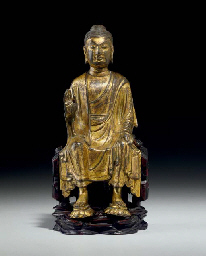A GILT-BRONZE SEATED FIGURE OF AKSOBHYA BUDDHATibet, 13th/14th Century Seated upright in dhyanasana on a double-lotus base, the right hand in bhumisparsa mudra (touching the earth), the left hand resting on the laps with the palm facing upward, wearing a thin dhoti falling in neat folds by the ankles, the arms and chest heavily bejeweled and the body framed by scarves billowing to the sides, the serene face in a meditative expression with downcast eyes and a subtle smile, framed by neatly coiled hair and a tall diadem, the face gilt, the body with traces of gilt and red lacquer. 14in (35.6cm) highFootnotesProvenance: Sotheby's, New York, 22 March 1989, Lot 276 Akshobhya Buddha is one of the Five Transcendent Buddhas and is said to reside to the east of the Diamond Realm and is the lord of the Eastern Pure Land Abhirati, in contrast to his counterpart, Amitabha of the Western Pure Land. Reflective of the name, which means 'Immovable One' in Sanskrit, Akshobhya Buddha is here shown rooted in meditation. The right hand is positioned downwards in a symbolic gesture that recalls Shakyamuni's victory over the armies and temptations of Mara. The present figure is emblematic of Western and Central Tibetan casting from the 13th and 14th centuries. Among the notable stylistic details are the distinctive petals on the lotus base, which are wide and rounded, typical of the period. The gilding at the face is applied in the 'cold gold' technique, which could involve the direct application of gold leaf to the surface, or more commonly in Tibet, the blending of gold dust or gold leaf with a binder into a ubiquitous solution, and then painting the amalgam onto the surface. This technique is one of the distinguishing characteristics of Tibetan metalworking of that time and region. The heavy application of gold to the face, and the traces of gold elsewhere on the body, indicate the importance of the present statue in Buddhist ritual. The sprues on the figure, remnants of the lost-wax casting process, are characteristic of Western and Central Tibetan bronze production, and help identify the geographic origin of the figure. Compare a strikingly similar 13th century copper-alloy figure of Akshobhya Buddha in a private collection (illustrated on Himalayan Art Resources, item no. 57354), which bears the same characteristics in posture, facial expression, lotus petals, cold-gilt face, and sprues, as the present figure. See, also, a 14th century hardstone-embellished copper-alloy figure of Akshobhya Buddha sold at Sotheby's, New York, 20 September 2022, lot 124, which has a very similar body, jewelry, and pedestal to the present figure, but has lotus stems at the sides rather than a shawl. A related Tibetan 13th/14th century copper-alloy figure of Amitabha sold in our London rooms, 16 May 2013, lot 273, displaying similar aesthetic and technical qualities to the present example, but with the Buddha of the Western Pure Land represented.
A GILT-BRONZE SEATED FIGURE OF AKSOBHYA BUDDHATibet, 13th/14th Century Seated upright in dhyanasana on a double-lotus base, the right hand in bhumisparsa mudra (touching the earth), the left hand resting on the laps with the palm facing upward, wearing a thin dhoti falling in neat folds by the ankles, the arms and chest heavily bejeweled and the body framed by scarves billowing to the sides, the serene face in a meditative expression with downcast eyes and a subtle smile, framed by neatly coiled hair and a tall diadem, the face gilt, the body with traces of gilt and red lacquer. 14in (35.6cm) highFootnotesProvenance: Sotheby's, New York, 22 March 1989, Lot 276 Akshobhya Buddha is one of the Five Transcendent Buddhas and is said to reside to the east of the Diamond Realm and is the lord of the Eastern Pure Land Abhirati, in contrast to his counterpart, Amitabha of the Western Pure Land. Reflective of the name, which means 'Immovable One' in Sanskrit, Akshobhya Buddha is here shown rooted in meditation. The right hand is positioned downwards in a symbolic gesture that recalls Shakyamuni's victory over the armies and temptations of Mara. The present figure is emblematic of Western and Central Tibetan casting from the 13th and 14th centuries. Among the notable stylistic details are the distinctive petals on the lotus base, which are wide and rounded, typical of the period. The gilding at the face is applied in the 'cold gold' technique, which could involve the direct application of gold leaf to the surface, or more commonly in Tibet, the blending of gold dust or gold leaf with a binder into a ubiquitous solution, and then painting the amalgam onto the surface. This technique is one of the distinguishing characteristics of Tibetan metalworking of that time and region. The heavy application of gold to the face, and the traces of gold elsewhere on the body, indicate the importance of the present statue in Buddhist ritual. The sprues on the figure, remnants of the lost-wax casting process, are characteristic of Western and Central Tibetan bronze production, and help identify the geographic origin of the figure. Compare a strikingly similar 13th century copper-alloy figure of Akshobhya Buddha in a private collection (illustrated on Himalayan Art Resources, item no. 57354), which bears the same characteristics in posture, facial expression, lotus petals, cold-gilt face, and sprues, as the present figure. See, also, a 14th century hardstone-embellished copper-alloy figure of Akshobhya Buddha sold at Sotheby's, New York, 20 September 2022, lot 124, which has a very similar body, jewelry, and pedestal to the present figure, but has lotus stems at the sides rather than a shawl. A related Tibetan 13th/14th century copper-alloy figure of Amitabha sold in our London rooms, 16 May 2013, lot 273, displaying similar aesthetic and technical qualities to the present example, but with the Buddha of the Western Pure Land represented.















Try LotSearch and its premium features for 7 days - without any costs!
Be notified automatically about new items in upcoming auctions.
Create an alert